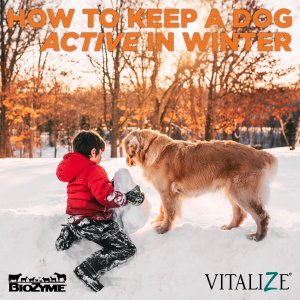
Canine Arthritis Symptoms
Dogs are often the family we didn’t know we needed. They love us unconditionally, under the conditions that we feed them, pet them and play fetch with them endlessly. That is until they age and start to feel the pain in their legs and joints.
Canine arthritis is a common and often painful condition in dogs, especially as they age. It is a degenerative joint disease that affects the cartilage, bones and surrounding tissues. As pet owners, understanding canine arthritis symptoms and supporting our furry friends can greatly enhance their quality of life. Once we understand the symptoms, we can help our canine companions stay active and comfortable for as long as possible.
At Vitalize®, we make supplements for horses, dogs and cats with proven solutions to keep your animal healthy and performing. We love our dogs like family, and we want to keep the game of fetch alive forever. That’s why we created this resource – to share what we’ve learned so your fluffy friends can benefit, too!
What is Canine Arthritis?
Arthritis in dogs typically refers to osteoarthritis, also known as degenerative joint disease (DJD). This chronic condition is caused by the breakdown of cartilage within the joints. Over time, the wear and tear can lead to inflammation, pain and reduced mobility.
While arthritis is more common in senior dogs, it can also affect younger dogs due to genetics, injury or developmental issues such as hip or elbow dysplasia. Large breeds like Labradors, German Shepherds and Golden Retrievers are more prone to the disease, but it can affect dogs of all sizes and breeds.
Canine Arthritis Symptoms
Recognizing canine arthritis symptoms early on can help ensure your dog gets timely care and support. Symptoms can be subtle at first but tend to worsen over time. Here are 7 of the most common signs:
1. Limping or Lameness
You may notice your dog favoring one leg or limping, especially after rest or physical activity. The limping might lessen as they warm up but return once they rest again. Look for limping, especially during long periods of physical activity.
2. Stiffness & Difficulty Moving
Stiffness, especially after sleeping or during colder weather, is a hallmark sign. Dogs may struggle to rise, lie down, or navigate stairs and inclines.
3. Decreased Activity or Reluctance to Exercise
Dogs with canine arthritis symptoms may seem less enthusiastic about walking, playing or jumping into the car. They may tire quickly or show a general lack of interest in physical activity. This is a sure sign, especially if your dog has always been enthusiastic and active. If your dog is typically lethargic, this might not be as much of a concern.
4. Behavioral Changes
Pain causes irritability, withdrawal or changes in temperament. A once playful pup might become grumpy or avoid contact, particularly if touched near the sore joints. If your typically docile dog bites or snaps at you, especially when petting, that is likely a cause for concern.
5. Licking or Chewing Joints
Dogs sometimes lick or chew the area where they feel discomfort as a way to “fix” the pain. This behavior can lead to hair loss or skin irritation over the affected joints.
6. Muscle Loss
As dogs avoid using a painful limb, the muscles around it may weaken and waste away. You may notice thinner limbs or uneven muscle mass.
7. Changes in Posture or Gait
Some dogs may develop a hunched back or appear to walk stiffly or unevenly. They may also alter their stance to compensate for joint pain.
Diagnosis of Canine Arthritis
If you suspect your dog has arthritis, it’s essential to consult your veterinarian. We hope that before your dog ever gets to this stage, you have already established a great patient-client relationship between your dog and your veterinarian. The better the relationship, the more your vet knows about your dog, and can help recognize when something isn’t 100% right. Diagnosis typically involves:
- Physical Examination: The vet will assess your dog’s range of motion, pain response and joint swelling.
- X-rays or Imaging: These internal pictures can reveal joint deterioration, bone spurs and other abnormalities.
- Joint Fluid Analysis: In some cases, fluid from the joint may be examined to rule out infection or immune-mediated diseases.
How to Support a Dog with Canine Arthritis Symptoms
While arthritis is not curable, many strategies can help manage the symptoms, slow the progression and increase your dog’s comfort and mobility.
Medications
Several medicines exist to provide temporary relief for your fur baby suffering from canine arthritis symptoms. First, non-steroidal anti-inflammatory drugs (NSAIDs) are often prescribed to reduce pain and inflammation. However, long-term use should be monitored for side effects.
In addition to NSAIDs, other pain medications like gabapentin or tramadol may be used. Other meds like corticosteroids are less commonly used due to potential side effects, but are helpful in some severe cases.
Joint Supplements
Many dogs benefit from joint supplements that contain hyaluronic acid, which may help protect cartilage and reduce inflammation. Omega-3 fatty acids, particularly from fish oil, also have anti-inflammatory properties.
Weight Management
One of the most effective ways to relieve pressure on arthritic joints is to maintain a healthy weight. Excess weight significantly increases the strain on joints and accelerates degeneration.
Tips to manage weight include:
- Feed a balanced, portion-controlled diet.
- Avoid excessive treats and table scraps.
- Consider weight-management or prescription diets recommended by your vet.
Exercise & Physical Therapy
While rest is essential during flare-ups, regular, low-impact exercise is crucial to keep joints mobile and muscles strong.
Best Exercises for Arthritic Dogs
- Short, frequent walks instead of long treks.
- Swimming or hydrotherapy, which offers resistance and buoyancy, reducing joint stress.
- Gentle play that doesn’t involve sudden stops, jumps, or twisting.
Physical Therapy
Certified canine physical therapists can design tailored exercise plans to improve range of motion and reduce pain. Techniques may include:
- Passive range of motion exercises
- Massage therapy
- Therapeutic ultrasound or laser therapy
Comfortable Living Environment
Making small adjustments at home can make a big difference for dogs with canine arthritis symptoms:
- Soft bedding: Provide orthopedic or memory foam beds to cushion joints.
- Non-slip flooring: Use rugs or mats on slippery floors to prevent falls.
- Ramps and stairs: Help your dog get onto furniture or into vehicles more easily.
- Warmth: Keep your dog warm, especially during cold months. Arthritis pain often worsens with cold, damp weather.
Alternative Therapies
Some dogs benefit from complementary therapies, though they should always be discussed with your veterinarian first.
Acupuncture
Acupuncture is typically an ongoing treatment to help relieve pain and stiffness. This ancient Chinese practice may help reduce pain and improve circulation. It in
Chiropractic Care
Canine chiropractic adjustments may improve alignment and relieve joint stress.
CBD Oil
Cannabidiol (CBD) has gained popularity for its potential to reduce inflammation and pain. Look for pet-specific formulations and consult your vet before use.
Surgery
If conservative treatments are no longer effective, surgical options can be considered. However, surgery is typically reserved for severe cases or when quality of life is significantly affected.
These include:
- Joint replacement, such as hip replacement
- Joint fusion
- Arthroscopic surgery to clean damaged joint tissue
Offer Your Dog Emotional Support
Physical care is just one part of managing canine arthritis symptoms. Dogs can experience emotional changes when they’re in chronic pain or less mobile.
Spend Quality Time Together
Even if your dog can’t play like they used to, they still love your company. Replace those rowdy games of fetch with gentle brushing, car rides or cuddle sessions. Your furry friend will repay you with sloppy kisses, and you will still enjoy the time.
Use Enrichment Toys
Puzzle feeders or scent games can engage their minds while keeping physical demands low. You want to keep them active and alert but reduce the pain.
Maintain Routine
Familiarity is the name of the game. Routine can be comforting, especially if arthritis has caused anxiety or reduced confidence.
Vitalize Can Help
Vitalize offers two joint supplements for your dog friends. All Vitalize products contain research-proven ingredients and possess quality certification from the National Animal Supplement Council (NASC). Vitalize products are unique because they contain MHB3®, a patented high molecular weight hyaluronic acid. Furthermore, the Trixsyn® Canine Performance also contains astaxanthin, a natural red algae-derived antioxidant, that assists with soft tissue health, muscular recuperation and exercise recovery. The astaxanthin provides comfort more quickly than HA, which normally takes up to 21 days.
Both Trixsyn Canine products are simple to use, require no prescriptions and don’t require the labor or mess of a shot or topical ointment. They come in an easy-to-use pump bottle. Dosage is determined by size and weight, and each dog gets 1 to 3 pumps on their food twice daily, depending on size.
Let’s learn more about MHB3.
MHB3 Hyaluronan
MHB3 Hyaluronan is a natural hyaluronic acid (HA) bioidentical to the HA naturally produced by the body. That means there is minimal risk of complications or malabsorption.
MHB3 is unique among other hyaluronic acid ingredients on the market due to its oral liquid formulation that allows for quick absorption and maximum effectiveness. Liquid supplementation with MHB3 is research-proven to be 3.8 times more effective than dry forms of hyaluronic acid.
MHB3 and HA are complete supplements. Glucosamine and chondroitin are considered first-generation of joint products. The American Academy of Orthopedic Surgeons now recommends against the administration of glucosamine and chondroitin for joint sufferers.
MHB3 currently holds 8 U.S. patents for its role in improving bone and joint health. Some of those include:
- For the prevention and maintenance of osteoarthritis
- For the prevention and maintenance of osteopenia – the precursor to osteoporosis
- For the prevention of osteophytes or bone spurs
- More generally, it has a role in improving joint health.
How MHB3 Helps
MHB3 improves the symptoms of osteoarthritis as well as symptom frequency.
A 30-day course of MHB3 treatment reduces friction within the joint and preserves protective cartilage, preventing the formation of bone spurs. This results in more fluid movement, less pain and increased range of motion.
Treatment with MHB3 decreases markers of bone breakdown, positively impacting bone mineral density and bone formation.
Study-backed outcomes associated with MHB3:
- Tissue hydration
- Anti-inflammation
- Cartilage protection
- Osteophyte prevention
- Pain reduction
- Increased range of motion
Introducing the Vitalize Products
Vitalize® Trixsyn® Canine
Vitalize Trixsyn Canine is a Level 1 liquid joint support for dogs that supports joint health using hyaluronic acid.
Vitalize® Trixsyn® Canine Performance
Vitalize Trixsyn Canine Performance is a Level 2 liquid product for dogs that supports total mobility utilizing hyaluronic acid and astaxanthin. It provides next-level support by supporting hip, joint and soft tissue health. The performance formula helps maintain a normal inflammatory response and supports normal exercise recovery.
Get your Vitalize Today!
If you are looking for supplements to support your furry friends before or when they show canine arthritis symptoms, we hope you give Vitalize a try. While we genuinely believe incorporating Vitalize into their diet will help your pup, our real goal is to provide resources to help you care for your canine companions.
So, support your pet’s joint health with Vitalize Trixsyn. Get your Vitalize today. We have made purchasing Vitalize as easy as possible. You can visit your local dealer to purchase Vitalize products. Locate a dealer near you today.
Perhaps you prefer the convenience of online shopping. You can shop online and have Vitalize delivered right to your front door.
Sign Up for Our Newsletter
Want to learn more about other ways to care for your furry friends? Visit the Vitalize blog today and sign up for our electronic newsletter.

